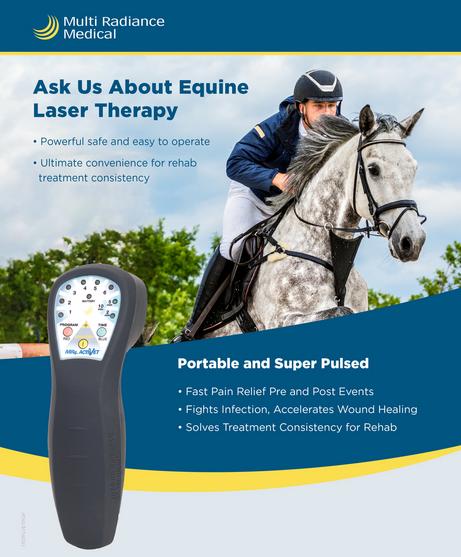Discover the Impressive Advantages of Equine Therapy for Psychological Recovery
Discover the Impressive Advantages of Equine Therapy for Psychological Recovery
Blog Article
How Laser Therapy in Equine Treatment Is Transforming Vet Look After Horses
Laser therapy has emerged as a transformative technique in equine vet treatment, supplying a non-invasive solution that accelerates recovery and boosts total health and wellness. The mobility and adaptability of laser therapy devices even more underscore their expanding indispensability among veterinarians.

Comprehending Laser Treatment
Understanding laser therapy is essential for appreciating its duty in equine treatment. Laser treatment, likewise called photobiomodulation, includes the application of details wavelengths of light to tissues, which can lead to different biological impacts. This therapeutic technique utilizes the power of light power to pass through the skin and underlying cells, boosting cellular processes and boosting cells repair work.
The technology behind laser therapy is based in the principle of photochemistry, where photons are taken in by chromophores within cells, leading to boosted ATP production and modulation of reactive oxygen types. This, consequently, advertises cellular expansion, reduces inflammation, and speeds up healing. Vet practitioners use different kinds of lasers, consisting of low-level lasers (LLLT) and high-power Class IV lasers, depending upon the specific restorative goals and the nature of the equine problem being treated.
Various laser wavelengths and power settings are meticulously chosen to target numerous tissue depths and attain preferred medical results. Safety and security protocols are paramount, as incorrect use can result in thermal damages or suboptimal healing effects. Therefore, an extensive understanding of laser treatment's mechanisms and applications is vital for its effective application in equine vet technique.
Advantages for Horse Health
The myriad benefits of laser treatment for equine wellness incorporate enhanced recovery, pain reduction, and enhanced flexibility. This innovative treatment technique leverages certain wavelengths of light to pass through tissues, stimulating cellular function and promoting fast tissue repair. The non-invasive nature of laser therapy makes sure marginal stress and anxiety and pain for the horse, assisting in a smoother recuperation procedure.

Improved wheelchair is one more vital benefit, particularly for efficiency and working steeds. By minimizing inflammation and pain, and boosting tissue repair, laser treatment helps in recovering joint function and muscle adaptability. The advancing effect of these advantages is not only a quicker go back to normal task yet also a general improvement in the horse's high quality of life. Thus, laser therapy stands as a transformative tool in contemporary equine veterinary treatment.
Usual Conditions Dealt With
Laser therapy has emerged as a flexible therapy alternative for a variety of typical equine problems. Furthermore, laser treatment is effective for conditions like osteoarthritis, where it assists alleviate joint swelling and advertise cells fixing.
Wound management is another area where laser therapy has shown considerable pledge. Persistent wounds or slow-healing ulcers can be especially tough in equines, however laser therapy improves cellular regeneration and improves blood circulation, hence expediting the healing procedure. Laser therapies have been successfully employed in handling unguis conditions such as laminitis and abscesses, minimizing pain and advertising much faster healing.
Equine professional athletes usually deal with performance-related problems like muscle mass soreness and stress cracks. Laser therapy help in reducing muscular tissue tiredness and expedites the recuperation of micro-injuries, therefore guaranteeing that steeds return to peak efficiency quicker. By resolving these diverse problems, laser therapy is changing the landscape of veterinary treatment, web offering a non-invasive, reliable option to traditional therapies.
Technology Behind Laser Treatment

Laser tools made use of in veterinary medicine commonly make use of low-level laser therapy (LLLT) or cool laser therapy. Unlike high-powered medical lasers, these devices operate at reduced power degrees, optimizing healing benefits while minimizing thermal damages. The power from the laser light stimulates adenosine triphosphate (ATP) production, enhances mobile metabolic rate, and increases cells repair work processes.
Modern laser treatment devices for equine treatment is created with flexible setups to deal with the details needs of different tissues and conditions. Equine Therapy. Parameters such as wavelength, power density, and treatment duration can be finely tuned, providing tailored restorative services. Furthermore, advancements in laser technology have led to the development of portable, portable tools, making it less complicated for vets to give therapy in a selection of setups, from centers to stables. This technological advancement is a foundation in the reinventing of equine vet care.
Success Stories and Study
Showcasing the substantial advantages of laser therapy, countless success tales and study brighten its transformative effect on equine wellness. One such situation involves a purebred racehorse struggling with persistent tendonitis. Traditional therapies yielded marginal enhancement, yet after integrating laser treatment into the routine, the equine exhibited considerable reductions in inflammation and discomfort within weeks, eventually going back to competitive racing.
An additional compelling example includes a dressage steed diagnosed with severe pain in the back, restricting its performance. A veterinary team utilized low-level laser treatment (LLLT) to target the swollen areas, resulting in marked enhancement in adaptability and a notable decrease in discomfort. Over a number of sessions, the equine reclaimed its peak kind, showcasing the efficiency of laser therapy in dealing with musculoskeletal problems.
Furthermore, a research study performed at a leading equine facility examined 50 horses with numerous soft cells injuries treated with laser treatment. The outcomes stood out: 85% of the steeds showed increased recovery times and boosted movement. These situations highlight the adaptability and efficiency of laser treatment in equine medicine, providing a non-invasive, scientifically-backed method to improving recuperation and efficiency in steeds.
Conclusion
Laser treatment is reinventing equine vet treatment anonymous by offering a non-invasive treatment that accelerates recovery, minimizes swelling, and eases pain. With its effectiveness in treating a series of conditions, from bone and joint injuries to persistent conditions like osteoarthritis, this technology significantly boosts equine health and wheelchair. The mobility and adaptability of laser treatment additionally underscore its transformative influence on vet methods, strengthening its duty as an important device in contemporary equine healthcare.
Report this page